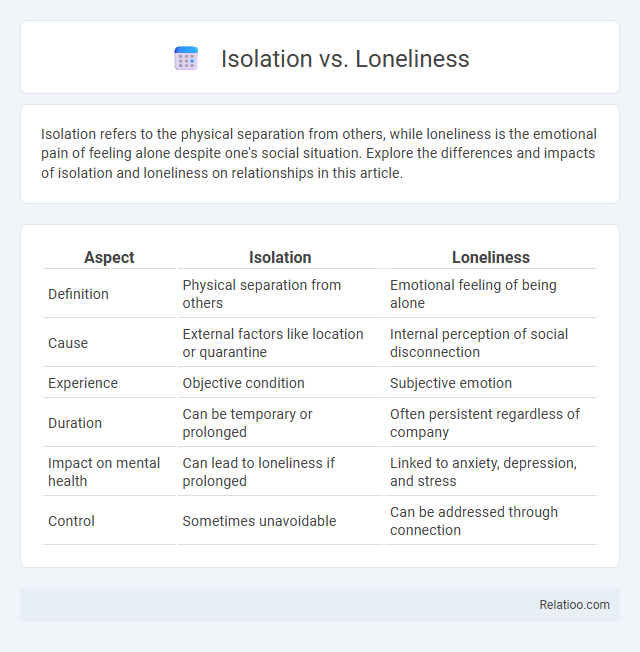Isolation refers to the physical separation from others, while loneliness is the emotional pain of feeling alone despite one's social situation. Explore the differences and impacts of isolation and loneliness on relationships in this article.
Table of Comparison
| Aspect | Isolation | Loneliness |
|---|---|---|
| Definition | Physical separation from others | Emotional feeling of being alone |
| Cause | External factors like location or quarantine | Internal perception of social disconnection |
| Experience | Objective condition | Subjective emotion |
| Duration | Can be temporary or prolonged | Often persistent regardless of company |
| Impact on mental health | Can lead to loneliness if prolonged | Linked to anxiety, depression, and stress |
| Control | Sometimes unavoidable | Can be addressed through connection |
Understanding Isolation and Loneliness
Isolation refers to the physical separation from others, while loneliness is the emotional experience of feeling disconnected or alone regardless of actual social contact. Understanding isolation involves recognizing its external, often involuntary nature, whereas loneliness is an internal psychological state that can occur even in the presence of others. Addressing both requires distinct approaches targeting social opportunities for isolation and emotional support for loneliness.
Key Differences Between Isolation and Loneliness
Isolation refers to the physical separation from others, often measurable by the lack of social contacts or interaction, while loneliness is the subjective emotional experience of feeling alone regardless of actual social connections. Key differences include isolation being an objective state, whereas loneliness is a psychological response that can occur even in the presence of others. Understanding these distinctions is critical for addressing mental health, as interventions for isolation often focus on increasing social contact, whereas alleviating loneliness may require emotional support and cognitive-behavioral strategies.
Psychological Impacts of Isolation
Isolation triggers significant psychological impacts such as increased anxiety, depression, and cognitive decline due to the absence of social interaction and emotional support. Chronic isolation disrupts brain function, reducing neuroplasticity and impairing memory and decision-making skills. Prolonged solitary environments exacerbate stress hormone levels, leading to elevated risks of mental health disorders and decreased overall well-being.
Emotional Effects of Loneliness
Loneliness triggers emotional effects such as increased stress, anxiety, and depression, distinct from the physical state of isolation. While isolation refers to the objective lack of social contact, loneliness is the subjective feeling of being disconnected, which can severely impact your mental health. Addressing loneliness is crucial to improving emotional well-being and preventing long-term psychological consequences.
Causes of Isolation in Modern Society
Isolation in modern society often stems from technological dependence, urbanization, and changing work patterns that reduce face-to-face interactions. Your social environment can be affected by remote work, digital communication replacing physical meetings, and the fragmentation of traditional community structures. These factors contribute to physical separation, which differs from loneliness, a subjective feeling, highlighting the importance of addressing the root causes of isolation for improved mental health.
Triggers and Risk Factors for Loneliness
Loneliness is often triggered by factors such as social isolation, major life changes, and lack of meaningful connections, while isolation refers to the physical separation from others without necessarily feeling lonely. Risk factors for loneliness include aging, chronic illness, low socioeconomic status, and social anxiety, which can intensify feelings of emotional distress. Unlike isolation, which can be voluntary or involuntary, loneliness is a subjective emotional state influenced by the quality of social interactions and individual perceptions.
How Social Connections Influence Well-being
Social connections significantly impact well-being by reducing feelings of loneliness and buffering the negative effects of isolation. While isolation refers to the objective state of being physically separated, loneliness is a subjective feeling of distress over a lack of meaningful relationships. Your mental and emotional health benefits from maintaining strong, supportive social ties that foster a sense of belonging and purpose.
Recognizing Signs of Chronic Loneliness
Chronic loneliness manifests through persistent feelings of emptiness, social withdrawal, and decreased motivation to connect with others despite physical proximity. Recognizing signs includes noting ongoing emotional distress, changes in sleep patterns, and increased anxiety or depression linked to perceived social isolation. Differentiating between temporary isolation and chronic loneliness is crucial for timely intervention and mental health support.
Strategies to Overcome Isolation and Loneliness
Isolation and loneliness are distinct experiences; isolation refers to physical separation from others, while loneliness is the emotional distress caused by feeling disconnected. Effective strategies to overcome both include building meaningful social connections through community groups, seeking professional support like counseling, and engaging in activities that foster a sense of purpose. You can reduce feelings of isolation and loneliness by prioritizing regular social interactions and developing hobbies that encourage engagement with others.
Building Resilience and Finding Support
Isolation involves physical separation from others, while loneliness is the emotional experience of feeling alone, even when surrounded by people. Building resilience requires recognizing these states and actively seeking meaningful connections, such as support groups or counseling, to maintain mental well-being. Your ability to find support systems transforms isolation into an opportunity for personal growth and emotional strength.

Infographic: Isolation vs Loneliness
 relatioo.com
relatioo.com